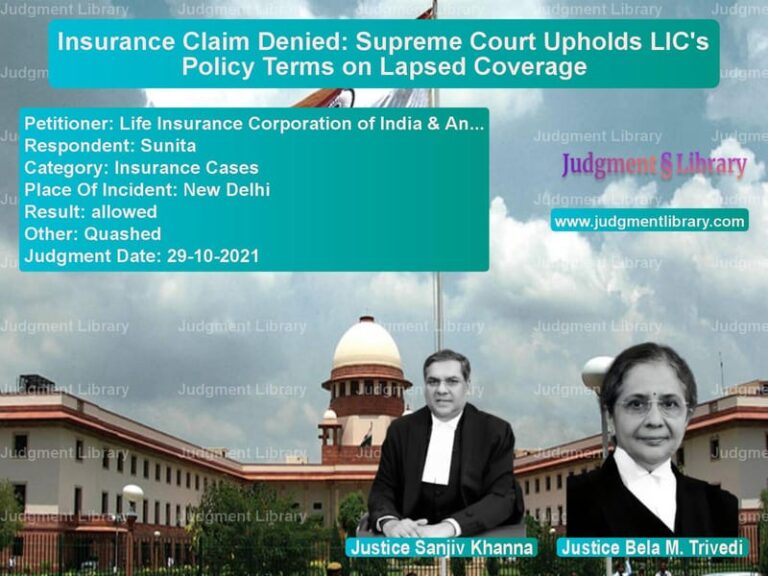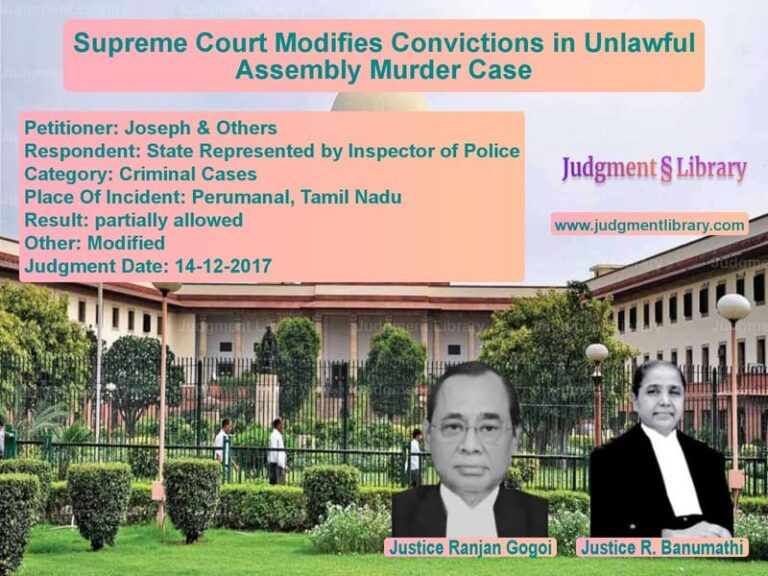Supreme Court Upholds High Court Decision in Attempt to Murder Case
The case of Champa Lal Dhakar vs. Naval Singh Rajput & Ors. was a pivotal decision in the legal landscape of India, particularly in how courts interpret attempt to murder charges under Section 307 of the Indian Penal Code (IPC). The Supreme Court, in its ruling dated January 4, 2019, dismissed the appeal by the complainant, upholding the Madhya Pradesh High Court’s order that set aside the framing of charges under Section 307 IPC and instead directed the trial court to reconsider the charges under Section 325 IPC.
The case underscores the importance of establishing intent in criminal cases, particularly in proving an attempt to murder. The Supreme Court clarified that for a charge under Section 307 IPC to hold, there must be sufficient evidence that the accused had the intention to commit murder.
Background of the Case
The dispute stemmed from an incident in which the complainant, Champa Lal Dhakar, alleged that he was attacked by a group of 17-18 people, including the respondents, with an intention to kill him. The complainant suffered a nasal bone fracture and other injuries, leading to the filing of a First Information Report (FIR) under multiple sections of the IPC, including Section 307 (Attempt to Murder).
Key Facts
- The complainant, Champa Lal Dhakar, alleged that he was attacked by the accused with the intent to commit murder.
- The FIR included charges under Sections 147, 148, 451, 325/149, 307/149, 294/149, and 506/149 IPC.
- The Additional Sessions Judge framed charges against the accused, including Section 307 IPC.
- The accused filed a revision application before the Madhya Pradesh High Court, challenging the framing of charges under Section 307.
- The High Court ruled that the injuries sustained by the complainant did not justify a charge under Section 307 IPC.
- The High Court directed that the charges should be reframed under Section 325 IPC, dealing with grievous hurt.
- The complainant appealed to the Supreme Court, challenging the High Court’s ruling.
Legal Issues Raised
Arguments by the Petitioner (Champa Lal Dhakar)
- The petitioner contended that the High Court erred in setting aside the charge under Section 307 IPC.
- He argued that the accused had attacked him with the clear intent to cause death.
- The presence of 17-18 attackers with weapons demonstrated an intent to commit murder.
- He maintained that his injuries were severe enough to justify an attempt to murder charge.
Arguments by the Respondent (Naval Singh Rajput & Ors.)
- The respondents argued that there was no direct evidence of intent to kill.
- The nature of injuries did not meet the threshold required for an attempt to murder charge.
- The trial court had erred in framing charges under Section 307 IPC.
- The High Court correctly directed that the charges be reframed under Section 325 IPC.
Supreme Court’s Observations
The Supreme Court, after reviewing the case, upheld the High Court’s decision and dismissed the appeal. The Court reasoned that the evidence did not establish the intent necessary for an attempt to murder charge.
“Considering the material/evidence on record and the medical certificate, it cannot be said that the intention of the accused was to cause the death of the complainant. Therefore, as rightly observed by the High Court, a charge under Section 325/149 ought to have been framed.”
The Court highlighted the distinction between grievous hurt and attempt to murder, emphasizing that a charge under Section 307 IPC requires a clear demonstration of intent to kill, which was absent in this case.
Supreme Court’s Final Judgment
The Supreme Court ruled:
- The High Court was correct in setting aside the charge under Section 307 IPC.
- The trial court must reconsider the charges and frame them under Section 325 IPC.
- The appeal by the complainant was dismissed.
“We are in complete agreement with the view taken by the High Court. The appeal is accordingly dismissed.”
Legal Precedents Considered
The Supreme Court referenced several key precedents:
- State of Maharashtra vs. Balram Bama Patil – Defined the ingredients required for an attempt to murder charge.
- Keshub Mahindra vs. State of Madhya Pradesh – Held that mere injuries do not necessarily prove an attempt to murder.
- Om Prakash vs. State of Punjab – Clarified the burden of proof for intent in attempt to murder cases.
Conclusion
The Supreme Court’s ruling in Champa Lal Dhakar vs. Naval Singh Rajput & Ors. reinforces the principle that intent is crucial in attempt to murder cases. Key takeaways include:
- Grievous hurt (Section 325 IPC) differs from attempt to murder (Section 307 IPC).
- For an attempt to murder charge to stand, there must be evidence of intent to kill.
- High Courts have the authority to revise charges based on evidence.
- Physical injuries alone do not necessarily warrant a Section 307 IPC charge.
This case serves as an important precedent for criminal law in India, ensuring that charges are framed appropriately based on evidence and legal principles.
Petitioner Name: Champa Lal Dhakar.Respondent Name: Naval Singh Rajput & Ors..Judgment By: Justice D. Y. Chandrachud, Justice M. R. Shah.Place Of Incident: Madhya Pradesh.Judgment Date: 04-01-2019.
Don’t miss out on the full details! Download the complete judgment in PDF format below and gain valuable insights instantly!
Download Judgment: Champa Lal Dhakar vs Naval Singh Rajput & Supreme Court of India Judgment Dated 04-01-2019.pdf
Direct Downlaod Judgment: Direct downlaod this Judgment
See all petitions in Attempt to Murder Cases
See all petitions in Bail and Anticipatory Bail
See all petitions in Judgment by Dhananjaya Y Chandrachud
See all petitions in Judgment by Mukeshkumar Rasikbhai Shah
See all petitions in dismissed
See all petitions in supreme court of India judgments January 2019
See all petitions in 2019 judgments
See all posts in Criminal Cases Category
See all allowed petitions in Criminal Cases Category
See all Dismissed petitions in Criminal Cases Category
See all partially allowed petitions in Criminal Cases Category







